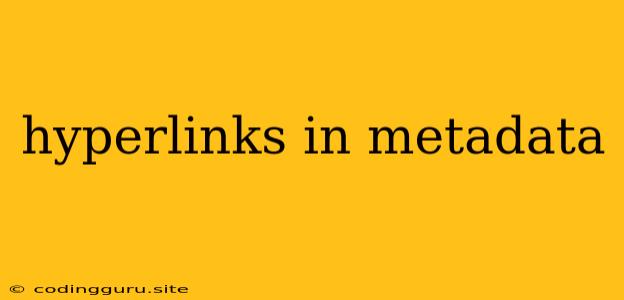The Importance of Hyperlinks in Metadata
Metadata, the informational backbone of digital content, plays a crucial role in organizing, discovering, and understanding information. One key element that can significantly enhance metadata is the inclusion of hyperlinks. These seemingly simple links can unlock a wealth of contextual information and enrich the overall experience for users.
Why are Hyperlinks Important in Metadata?
Imagine a scenario where you're browsing a vast online library, looking for a specific book on astrophysics. You find a promising entry in the metadata, listing "astrophysics" as the subject. But, without hyperlinks, you're left with a vague, isolated piece of information. You have no way of knowing what specific astrophysics topics the book covers, its level of difficulty, or its author's reputation.
Hyperlinks change this situation entirely. By incorporating hyperlinks into metadata, you can connect your metadata entries to relevant sources of information, providing context and depth to your data.
Here are some key benefits of using hyperlinks in metadata:
- Contextualization: Hyperlinks allow you to link metadata entries to external resources, providing users with deeper insights and contextual understanding. For example, linking the subject "astrophysics" to a Wikipedia article on the subject will give users immediate access to a wealth of information about the field.
- Navigation: Hyperlinks provide a direct route to relevant information, eliminating the need for users to manually search for details. Linking a book's title to its publisher's website allows users to quickly find more information about the book, its author, and potential reviews.
- Discovery: Hyperlinks can help users discover related content. For example, linking a book's author name to a list of their other publications can lead users to explore more of their works.
- Accuracy and Consistency: By linking metadata entries to authoritative sources, you ensure the accuracy and consistency of your data. For instance, linking a geographical location to a map service provides users with a precise understanding of the location's coordinates.
- Data Validation: Hyperlinks can be used to validate metadata entries. By linking a product's SKU to a manufacturer's database, you can verify the product's authenticity and specifications.
How to Implement Hyperlinks in Metadata
Implementing hyperlinks in metadata can vary depending on the specific metadata format and system you're using. However, the general principle remains the same. You need to create a link that points to a relevant external resource and embed this link within the metadata field.
For instance, in a Dublin Core metadata schema, you might link the "creator" field to the author's website using a <dc:creator> tag with the link embedded within the tag's content.
Example:
John Doe
Real-World Examples
Hyperlinks in metadata are widely used across various domains.
- Libraries and Archives: Libraries use hyperlinks in their online catalogs to link book titles to author biographies, publisher information, and online reviews.
- Museums and Galleries: Museum databases use hyperlinks to connect artifacts to historical timelines, research articles, and virtual tours.
- E-commerce Websites: Online retailers utilize hyperlinks in product descriptions to link to customer reviews, product specifications, and manufacturer information.
- Research Databases: Scientific databases use hyperlinks to connect research papers to author profiles, related publications, and funding sources.
Conclusion
Hyperlinks are an essential tool for enriching metadata. They provide context, facilitate navigation, enhance discovery, and ensure data accuracy. By embracing hyperlinks in your metadata strategies, you can unlock a wealth of potential for users and improve the overall usability and value of your information resources.
